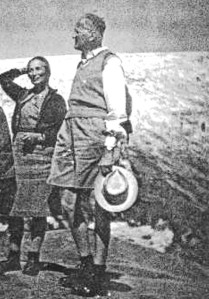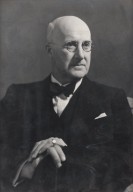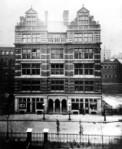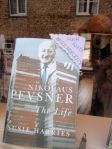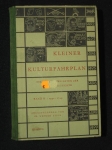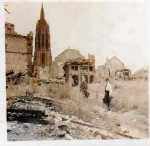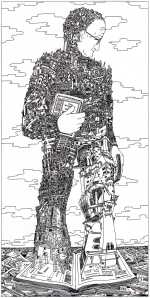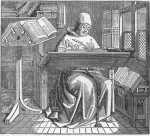talking about Nikolaus Pevsner – the man, his life and his work
Bibliography
![]() I’m told the previous link to the full Pevsner bibliography is broken – so here‘s a new one. There will be a selective bibliography in the paperback edition, which should be out at the beginning of April 2013 from Pimlico.
I’m told the previous link to the full Pevsner bibliography is broken – so here‘s a new one. There will be a selective bibliography in the paperback edition, which should be out at the beginning of April 2013 from Pimlico.
Mr Troup Horne presents his compliments
One of the gifts of google to the biographer is the ability suddenly to put a face to someone who has just been a name. Birkbeck College has put online a collection of its historical photographs, and amongst them is an image of George Francis Troup Horne, who was Secretary to the college and Clerk to its Governors from 1919 to 1952.
He was also one of the most significant contacts of Pevsner’s life, in that it was Troup Horne, a neighbour in Hampstead, who seems to have suggested to Birkbeck that they might use Pevsner as a lecturer during the war, when many of the college’s regular staff had been called up. Pevsner’s first lecture at Birkbeck, early in 1940, was entitled ‘Enjoyment of Architecture’. By the time he gave his second, he had been briefly interned as an enemy alien and spent an equal number of months clearing the remains of bombed buildings from the streets of North London.
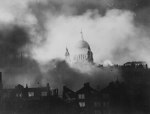
Photo: Herbert Mason
The first talk was not followed by any offer of regular employment, and Pevsner’s second appearance was not in Birkbeck’s lecture hall but on its roof – again, probably thanks to Troup Horne. After the devastating fire bombing of the City on December 29, 1940 – the ‘second Fire of London’ – compulsory firewatching was introduced. Standing between Chancery Lane and Fetter Lane, Birkbeck – then in Bream’s Buildings – had been lucky to escape the worst of the damage in the City and it was now anxious to comply with the regulations. Pevsner was signed up, and saw it as a welcome release from rubble-shovelling: ‘It is by no means the kind of return to academic surroundings that one would fancy,’ he wrote, ‘but it is a decided improvement’.
Troup Horne also took his turn on the roof, and seems to have put the time to good use. A portly man, he was an excellent cook and selected members of the college would sometimes receive a welcome invitation: ‘Mr Troup Horne presents his compliments and has prepared a pigeon pie’.
 Troup Horne would feature again as a mentor after the war, this time as one of the four sponsors of Pevsner’s naturalisation as a British citizen. He is commemorated in London I: the Cities of London and Westminster, published in 1957, four years after his death: ‘To the memory of G. F. Troup Horne and the nights of 1941-1944 at the old Birkbeck College in Bream’s Buildings’.
Troup Horne would feature again as a mentor after the war, this time as one of the four sponsors of Pevsner’s naturalisation as a British citizen. He is commemorated in London I: the Cities of London and Westminster, published in 1957, four years after his death: ‘To the memory of G. F. Troup Horne and the nights of 1941-1944 at the old Birkbeck College in Bream’s Buildings’.
Much Ado about Pevsner
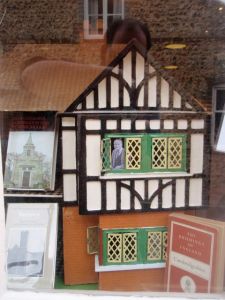
Much Ado Books in Alfriston, Lewes, have given their window over to a splendid Pevsner display, with the man himself peering benignly out of the window of one of ‘his’ buildings. It’s very good to see that affection for him is no less enduring than respect.
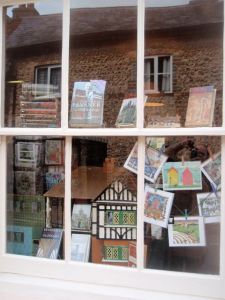
Pevsner and the phasmagram
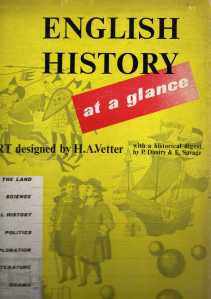
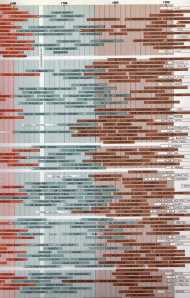 In 1944, while he was sitting in at the Architectural Review for Jim Richards, Pevsner described himself as ‘working on a Chart’. This was probably the curiosity which emerged from the Architectural Press in 1949 under the title ‘‘English History at a Glance’ – a slim volume the size and shape of an atlas which identified the milestones in each area of human progress and plotted them all on a single map.
In 1944, while he was sitting in at the Architectural Review for Jim Richards, Pevsner described himself as ‘working on a Chart’. This was probably the curiosity which emerged from the Architectural Press in 1949 under the title ‘‘English History at a Glance’ – a slim volume the size and shape of an atlas which identified the milestones in each area of human progress and plotted them all on a single map.
Modelled on the German Kulturfahrplan or ‘Culture Timetable’, the ‘Chart’ coordinated events and individuals ‘according to the changing spirit of ages’ – very much Pevsner’s kind of thing: running one’s eye down the Chart, one could read off the simultaneous developments in art, science, politics, economics and religion.
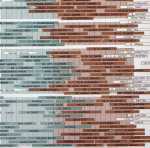 It was a perfect tool for identifying people working ahead of their time, Pevsner’s ‘pioneers’. An innovator in any field might be given a label of one colour to designate the time of his birth, but this might project into a preceding or succeeding period and appear against a background of a different colour if his ideas were out of synch with his age. In the field of architecture, ‘pioneers’ such as Voysey, Mackintosh and Charles Holden are coloured conspicuously in the hue of the following stylistic period, whereas Lutyens carries the mud-brown label of the ‘Romantic and Industrial’ period well into modern times.
It was a perfect tool for identifying people working ahead of their time, Pevsner’s ‘pioneers’. An innovator in any field might be given a label of one colour to designate the time of his birth, but this might project into a preceding or succeeding period and appear against a background of a different colour if his ideas were out of synch with his age. In the field of architecture, ‘pioneers’ such as Voysey, Mackintosh and Charles Holden are coloured conspicuously in the hue of the following stylistic period, whereas Lutyens carries the mud-brown label of the ‘Romantic and Industrial’ period well into modern times.
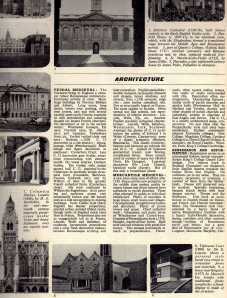 The Chart ends with a typically Pevsnerian statement: ‘Controversial placing of names is better than no decision on placing at all.’ Pevsner is directly credited with having provided the background notes on architecture that clarify the Chart (while Michael Tippett did the honours for music, and Robert Birley for history); but might he also lurk behind the ‘P. Dantry’ who, with ‘E. Savage’, is named as author of the historical digest ? The designer is ‘H.A. Vetter’.
The Chart ends with a typically Pevsnerian statement: ‘Controversial placing of names is better than no decision on placing at all.’ Pevsner is directly credited with having provided the background notes on architecture that clarify the Chart (while Michael Tippett did the honours for music, and Robert Birley for history); but might he also lurk behind the ‘P. Dantry’ who, with ‘E. Savage’, is named as author of the historical digest ? The designer is ‘H.A. Vetter’.
Right links for Pevsner reviews, bibliography
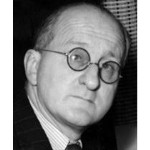 Sorry – the previous link to pre-publication reviews of Nikolaus Pevsner: the Life was wrong. Here is the correct one http://www.pevsnerinfo.cswebsites.org/default.aspx?page=26938
Sorry – the previous link to pre-publication reviews of Nikolaus Pevsner: the Life was wrong. Here is the correct one http://www.pevsnerinfo.cswebsites.org/default.aspx?page=26938
 One of the reviews mentions the lack of a bibliography. Just to repeat a previous post: the 66-page bibliography would have tipped the book over the 900 page mark, which might have been overdoing it a bit – it can be found on the pevsner info website at http://www.pevsnerinfo.cswebsites.org/default.aspx?page=26867
One of the reviews mentions the lack of a bibliography. Just to repeat a previous post: the 66-page bibliography would have tipped the book over the 900 page mark, which might have been overdoing it a bit – it can be found on the pevsner info website at http://www.pevsnerinfo.cswebsites.org/default.aspx?page=26867
Colonel Pevsner
Pevsner’s wardrobe will be the subject of another post – but one of his more improbable outfits was the uniform of a British colonel. ‘I like my uniform,’ he wrote, ‘it is comfortable, sensible and roomy – I wouldn’t mind always wearing battle dress.’ He wore it as the leader of a team sent in 1946 to the British Zone of Occupied Germany by the Council on Industrial Design. British exports needed to improve in order to compete in post-war Europe and the COID had been charged by the Board of Trade with discovering the secrets of the opposition’s success. Pevsner’s mission was to establish the current state of German design.
He spent his time, he said, ‘looking at Bakelite and hoovers’. But he was also in touch with the British Political Intelligence Department, for whom he was ostensibly writing an article on ‘German Folk Art’. And, perhaps nearest to his own heart, he was consulting on the rebuilding of historic monuments in Germany.
It was the devastation to Germany’s towns and cities rather than the superiority of their plastics that, not surprisingly, struck him most forcibly. ‘Germany remains a disturbing and dreadful spectacle .… It’s enough to make one weep – and believe me, at times I can hardly stop myself…. I know of course “they asked for it and they got it”, but…..’
One of the COID team’s principal destinations was Frankfurt am Main. The photographs below show Römerberg, the central square of the old town, with the late-Gothic Alte Nikolaikirche – at the turn of the century, and at the time of Pevsner’s visit two years after the Allied bombing of March 1944 (in the team’s own photograph, with Pevsner in the centreground).
Buildings of England encapsulated
On the Bibliography page of my website I have used – with the kind permission of the artist, Gerald Nason – a marvellous drawing of Pevsner, composer of The Buildings of England, which is itself composed of a multitude of the buildings. (Click on the image to see it reproduced at a size where you can appreciate the detail.) The drawing originally appeared in the Architectural Review in October 1984 accompanying an article by Professor Robert Harbison entitled ‘With Pevsner in England’.
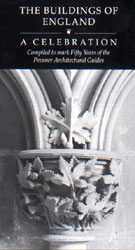 You will also find the drawing reproduced in Bridget Cherry and Simon Bradley’s ‘The Buildings of England: a Celebration’. That volume was compiled to mark fifty years of the BoE series – now coming up to its 60th anniversary.
You will also find the drawing reproduced in Bridget Cherry and Simon Bradley’s ‘The Buildings of England: a Celebration’. That volume was compiled to mark fifty years of the BoE series – now coming up to its 60th anniversary.
Pevsner and the spirit of the ant
Pevsner did not greatly care for the methods of Auguste Forel, the Swiss psychiatrist to whom his mother regularly turned when depression overcame her. ‘The whole cure was wrapped in secrecy… The room, the techniques of suggestion and hypnosis – we had no way of knowing about them,’ he wrote later.

Nika c. 1912
Forel – Nobel laureate, socialist, teetotaller, and an expert on sexual problems – was also a leading authority on the behaviour of the ant. He was impressed by the grim resolution of the younger Pevsner and in 1912 paid him (or his mother) the compliment of his own sub-species: Cremastogaster [sic] distans r. pevsnerae, a Venezuelan version of a type of ant found from Texas to Argentina. ‘Plus petite que l’espèce typique,’ according to Forel, at 2.8 – 3.2 millimetres long.
Biography
- buildings
- architecture; buildings; architectural history; German literature; diarist
- German literature
- architectural history
- Beatles
- Lennon
- granny glasses
- In HIs Own Write
- Jerusalem
- Kollek
- Old City
- Philip Johnson
- Lawrence Halprin
- Bruno Zevi
- Beethoven
- Gewandhaus
- Hans Gal
- Huyton
- Nikisch
- Leipzig
- music
- Tchaikovsky
- Thomas Beecham
- Conchita Supervia
- diarist
- Victorian
- Penguin
- Buildings of England
- architecture
- Pevsner
